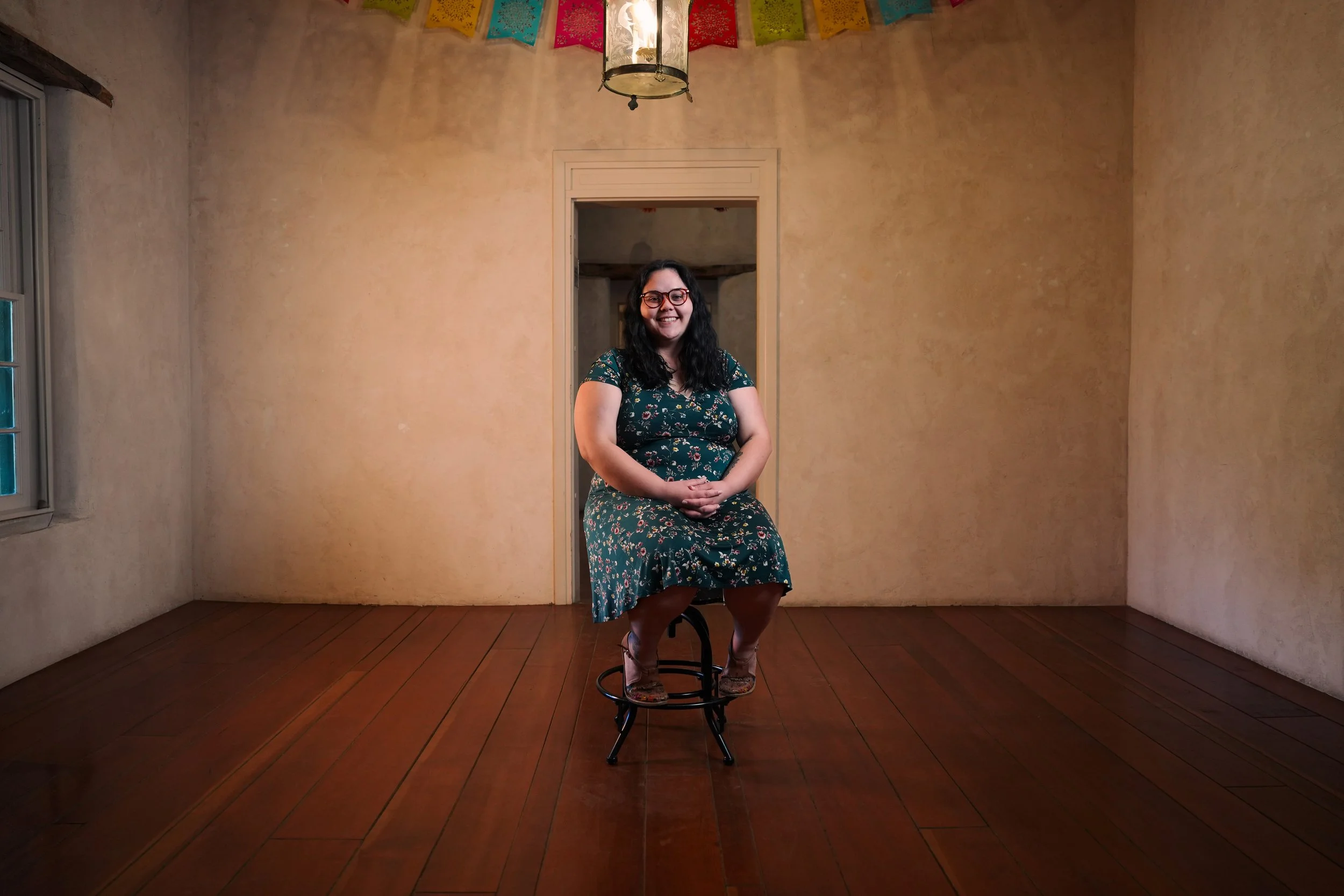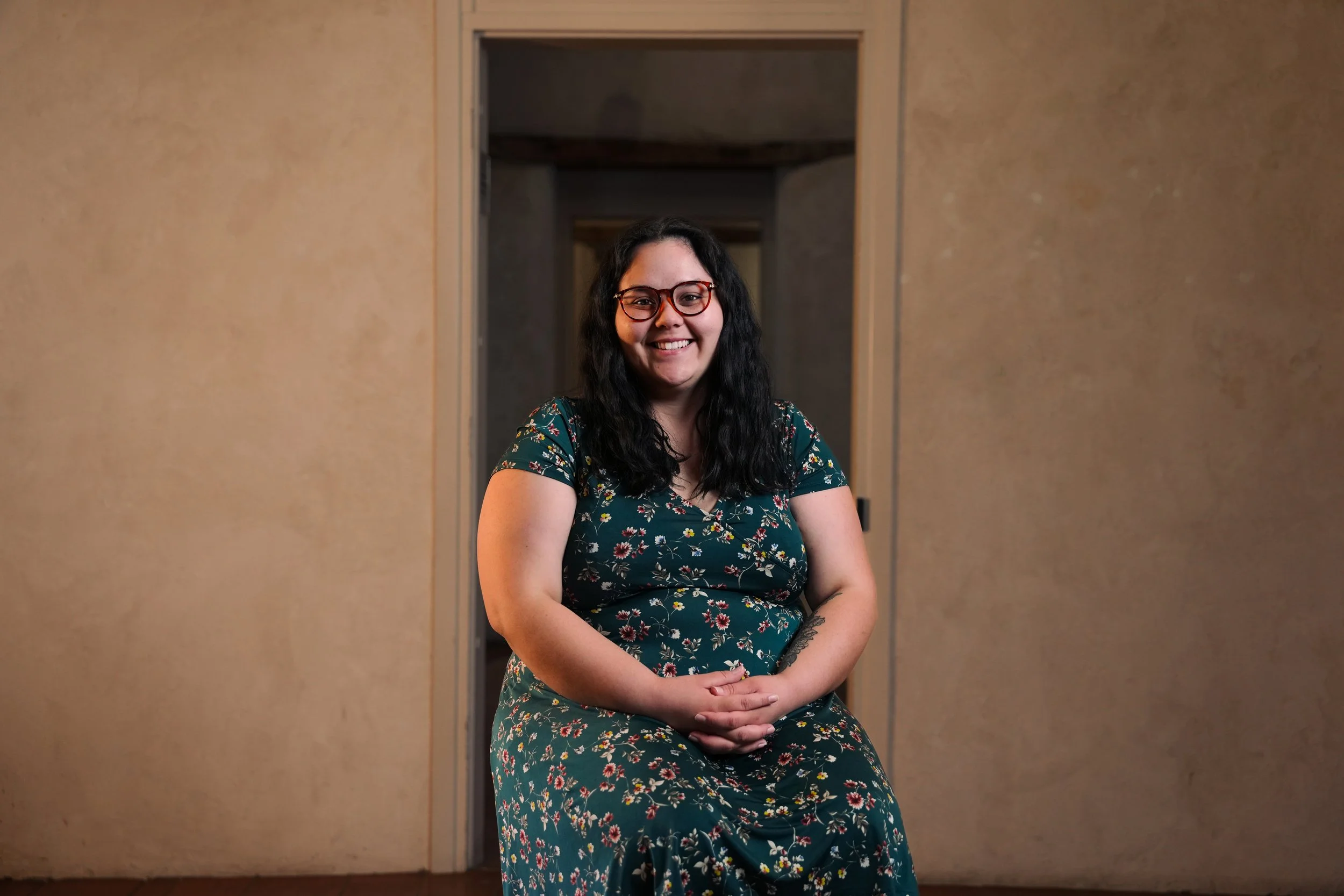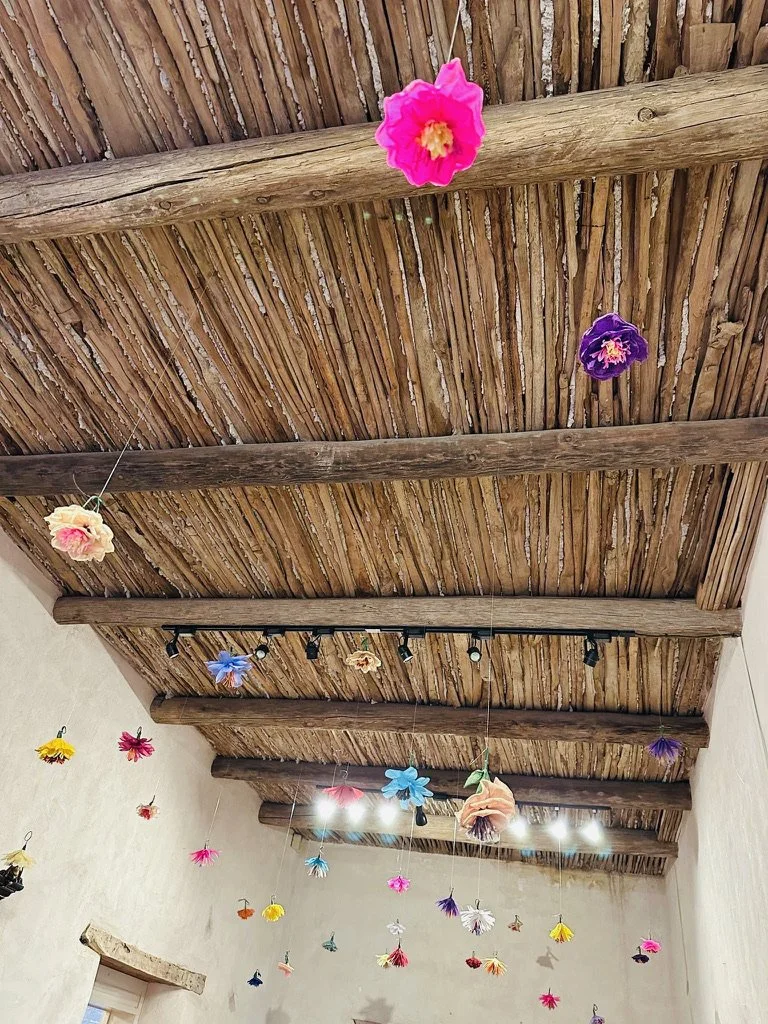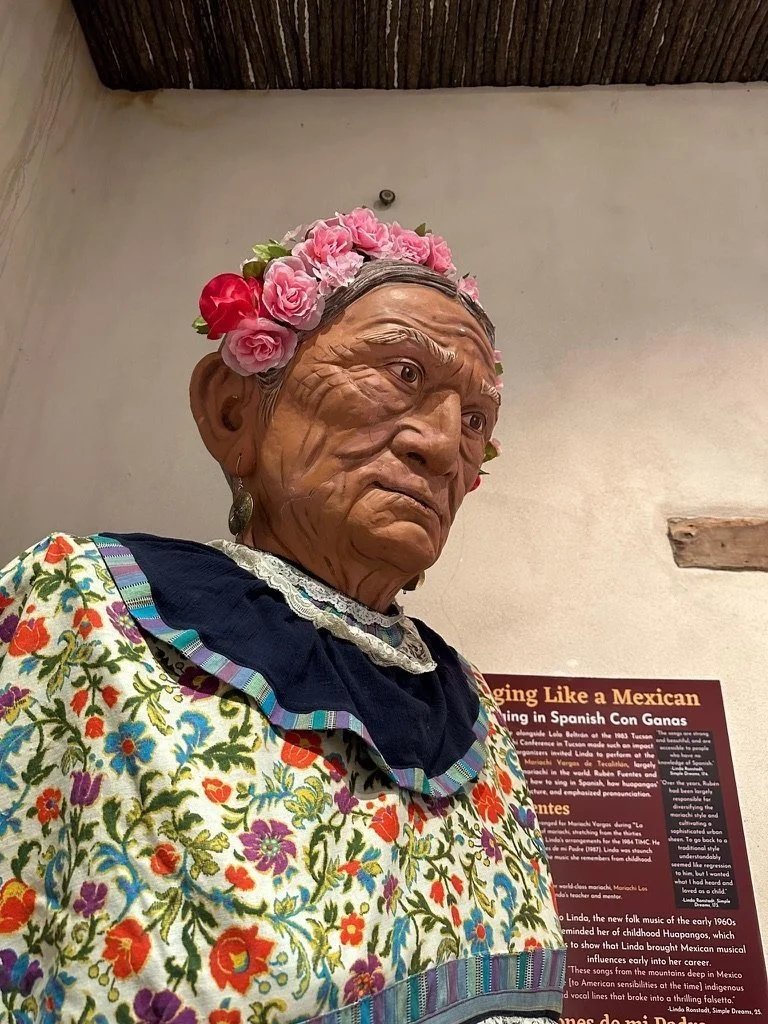Meet the first Executive Director of Los Descendientes de Tucson
Leer este artículo en Español
Los Descendientes de Tucson’s new Executive Director, Rikki Riojas photographed at the historic Sosa-Carrillo House. Photo credit: Dominic Rischard
Surrounded by the brutalist municipal architecture of the Tucson Convention Center complex, one adobe structure remains standing in what was the once vibrant neighborhood known as La Calle. In the 1960’s, urban renewal policies in Tucson were responsible for the razing of roughly 250 homes. Tucson was growing, and standing in the way of ‘modernization’ was a predominantly Mexican-American neighborhood at odds with the City’s vision of progress. And so the bulldozers came.
Decades later, the Sosa-Carrillo house stands defiant. Today it is the home of the Mexican American History and Heritage Museum and Los Descendientes del Presidio de Tucson, the historical preservation society charged with its caretaking.
Wearing a dark green dress with flowers, Rikki Riojas walks in her leather huaraches through the wooden floors of the historic home. She’s listening for a chirping sound. A lone smoke alarm needs a battery change, another item on the punch list of this home that dates back to Tucson in the 1880s.
For Riojas, change is just part of the territory. I met her last summer while she was serving as Board President of Los Descendientes, affectionately known as Los Des. We talked about the opportunities and challenges that come with leading an organization with such a rich past—into the future. At the time, the topic of conversation was commissioning a new logo to reflect a more inclusive direction for Los Des. Today, Riojas has bigger projects on her mind.
Earlier this month, Riojas became the organization’s first executive director, thanks to a two-year grant from the Mellon Foundation. The $750,000 award will support construction costs at Sosa-Carrillo, new spaces for presentations and exhibits, and improved accessibility. It will also increase organizational capacity for Los Descendientes through two paid administrative positions, Riojas’ being one of them.
She is also the museum’s co-director along with Alisha Vasquez, who serves as community director. Together, they are responsible for programming and exhibits, rentals in the house, applying for museum grants, tracking the budget, and reporting to the board. The pair are also members of the Executive Board of Los Descendientes.
Betty Villegas was the museum’s former co-director. In 2023 she stepped down when she was appointed to the Arizona state legislature. The board honored Villegas’ contributions with the title of Co-Founder and Curator Emerita. Riojas, herself is hoping that next year someone takes over the president position so Riojas can focus on the museum.
We caught up with Riojas to get the latest chisme during a video shoot El Sur was doing for the University of Arizona Confluence Center, another Mellon Foundation recipient.
“These spaces can be spaces of pain, but also of healing and intergenerational learning so that our histories are passed on rather than erased,” says Riojas
El Sur: What inspired your love of Mexican American studies and history?
Rikki Riojas: “History and the stories of people have always drawn my interest. I loved reading historical diaries as a kid, the lives of other people are fascinating to me. My love for Mexican American Studies started with a class I took titled Culture, Community & Identity taught by Dr. Lydia Otero. As part of this class, we were tasked with walking around what used to be the Barrio. It forced me to take a deeper look at the buildings I had only previously spared a glace for. This class, and the rest of the MAS classes I took challenged the American History classes I had in public school. It wasn’t just facts taught from a textbook, it was analysis of how language, culture, and people all intersect to create a diverse and complicated story. Learning a different way to view history, through a community focused and driven lens, is where I found my love of Mexican American studies.”
El Sur: Why is it important to preserve spaces like the Sosa-Carrillo House?
RR: “History is tied to people and language, but it is also tied to place. The removal of the Barrio was an attempt to remove the people and their culture from the area. This intentional removal can also be seen in the 1970’s remodel of the Sosa-Carrillo House and the Tucson Heritage Foundation’s insistence that the only significant part of the house was due to Governor John C. Fremont. To maintain the Sosa-Carrillo House and similar spaces as a community space is an act of perseverance and preservation. It is a symbol that the Mexican community was there and is still here today. It forces people to confront the terrible treatment Mexicans, Chinese, and African Americans faced under the guise of progress for Tucson’s wealthier residents. Having a space like the Sosa-Carrillo House that is community run allows for partnership with other pushed out and marginalized communities. These spaces can be spaces of pain, but also of healing and intergenerational learning so that our histories are passed on rather than erased.”
Paper flowers in vivid colors adorn the ceiling of the Sosa-Carrillo House
El Sur: What is your vision for Los Descendientes de Tucson as its first Executive Director?
RR: “My vision is to establish Los Descendientes as a community centered organization while expanding intergenerationality, community programming, and learning opportunities. It is not just enough to exist. Los Descendientes needs to be proactive in showing our sustained commitment to celebrating community and promoting the cultures of Tucson.”
El Sur: You recently changed the logo for Los Des. How did that come about, and why?
RR: “The decision to change the logo came about as a result of discussions between the board regarding who Los Descendientes is and where we want to go. We wanted a logo which reflected the founding of Los Descendientes, but that was also inclusive of the other cultures and identities held by current Los Descendientes members. The original logo featured a Spaniard with a lance riding a horse surrounded by the text Los Descendientes Del Presidio De Tucson. This logo reflected the original founding members of Los Des, descendents of the Presidio. We also recognized that a Spaniard on a horse has ties to colonialism.
Our mission is to preserve, promote, and celebrate the people and history of the founding cultures of Tucson and the Pimeria Alta and we felt the colonial aspect, while an important conversation to have, did not represent the ultimate mission of promoting and celebrating all of the founding cultures of Tucson. Since our founding in 1990, Los Des has expanded to include descendents of a non-spanish origin such as Native American, Mexican, Chinese, and African American descendents. We also welcome those who are not descendents of Tucson and just interested in preserving and learning about history.
The new logo of Los Descendientes de Tucson
Our new logo features our name along with the Santa Cruz River and A Mountain inside of an outline of a mission. The mission outline harks back to our origins as a Mexican American organization. The decision to feature the Santa Cruz and A-Mountain was made due to the importance both of these places had to the settlement of Tucson. Los Des programming decisions focus on inclusivity and highlighting the voices of those in the community who have been ignored. We feel our new logo better reflects this work as well as the makeup of Los Descendientes members.”
El Sur: How does honoring our past help us understand Latinx futures?
RR: “Each generation goes through their own struggles, but we are much more alike than we are different. Honoring our past and understanding why decisions in the past were made helps us to see the parallels to what is currently going on, but also helps us to advocate for the community. Knowing the accomplishments our elders made when it comes to preservation, wages, and even high school and college degrees helps us to see how far we’ve come even in just two generations. From there, we can ask ourselves how to continue this progress for future generations. What types of programs can we enact to ensure Latinx continue to graduate high school and have the choice to pursue higher education? Can we highlight housing programs to ensure families aren’t priced out of their generational homes? Asking these types of questions also helps to clarify the current and future struggles of the community, and allows us to be proactive in supporting Latinx futures.”
El Sur: What's it like sharing space with an organization like Borderlands Theatre? What opportunities does this create?
RR: “Getting to share a space with Borderlands Theatre has provided an opportunity for collaboration and learning. Borderlands Theatre is known on a national scale and has a history of wonderful community inclusive programming. Marc and Milta along with the other staff have extensive experience both in the nonprofit and arts spheres and we’re thankful anytime they provide advice or words of wisdom. We have only done a couple of collaboration events in the past, but we hope to do more in the future especially as the museum expands the types of programming we do. It’s always fun to see what they are working on when they have props at the museum, there is so much behind the scenes work for their community events that I wouldn’t have even imagined.”
One of the many exhibits at the Sosa-Carrillo House. It has since been taken down in preparation for renovations this summer.
El Sur: What exhibits are you planning for next time you open?
RR: “When we open in 2025 it will be with three new exhibits, one rethought older exhibit, and additional community programming. Our rethought exhibit will be our previous Sosa & Carrillo Family room. We are planning to expand this exhibit to go more in depth on the families, their history, and their contributions to Tucson. This exhibit will have more text to it, but also more pictures and interactivity.
The first new exhibit is one I'm currently calling “Urban Renewal in Context”, through this exhibit we will discuss the long story leading up to Urban Renewal along with what happened after and plans for the future. My goal for this exhibit is to get people to think about how the past has shaped the future of the TCC campus and surrounding neighborhoods from hotels and apartments to walkways and landscaping.
The second new exhibit is a Native American partnership between the Mexican American Museum and the Tohono O’odham Young Voices Podcast and Brandon Varela. This audio and visual exhibit on Tohono O’odham culture and history will bring local indigenous perspectives into the Sosa-Carrillo House. Los Descendientes recognizes that the land the Sosa-Carrillo House resides on has long been Native American land and we are working towards greater inclusion of the importance of Native American tribes and their history. This exhibit and partnership is a first step towards this, but it will not be our last.
The third new exhibit is one that I’m calling “Stories of the Barrio”. Part of this exhibit will include a partnership with Latinos in Heritage Conservation’s Abuelas Project. The Abuelas Project aims “to collect, curate, and amplify stories about places that matter to Latinx communities in the U.S. and Puerto Rico” with a focus on the grandmothers and strong women in our lives. The Mexican American Museum will also be doing community outreach to compile the family stories and traditions which make up the rich culture in the Barrio. These pictures and stories will be displayed on the walls in one of our rooms, giving the feel of family pictures on the wall at your Nana’s house. My hope is that people are able to walk into the room and see not only their families, but the other families of the Barrio and the many faces that make up our diverse community.
During 2025, the museum is also partnering with Dr. Sunaura Taylor to bring community programming, historical, and art exhibits surrounding ground water contamination in Tucson’s Southside and the community response to it.”




